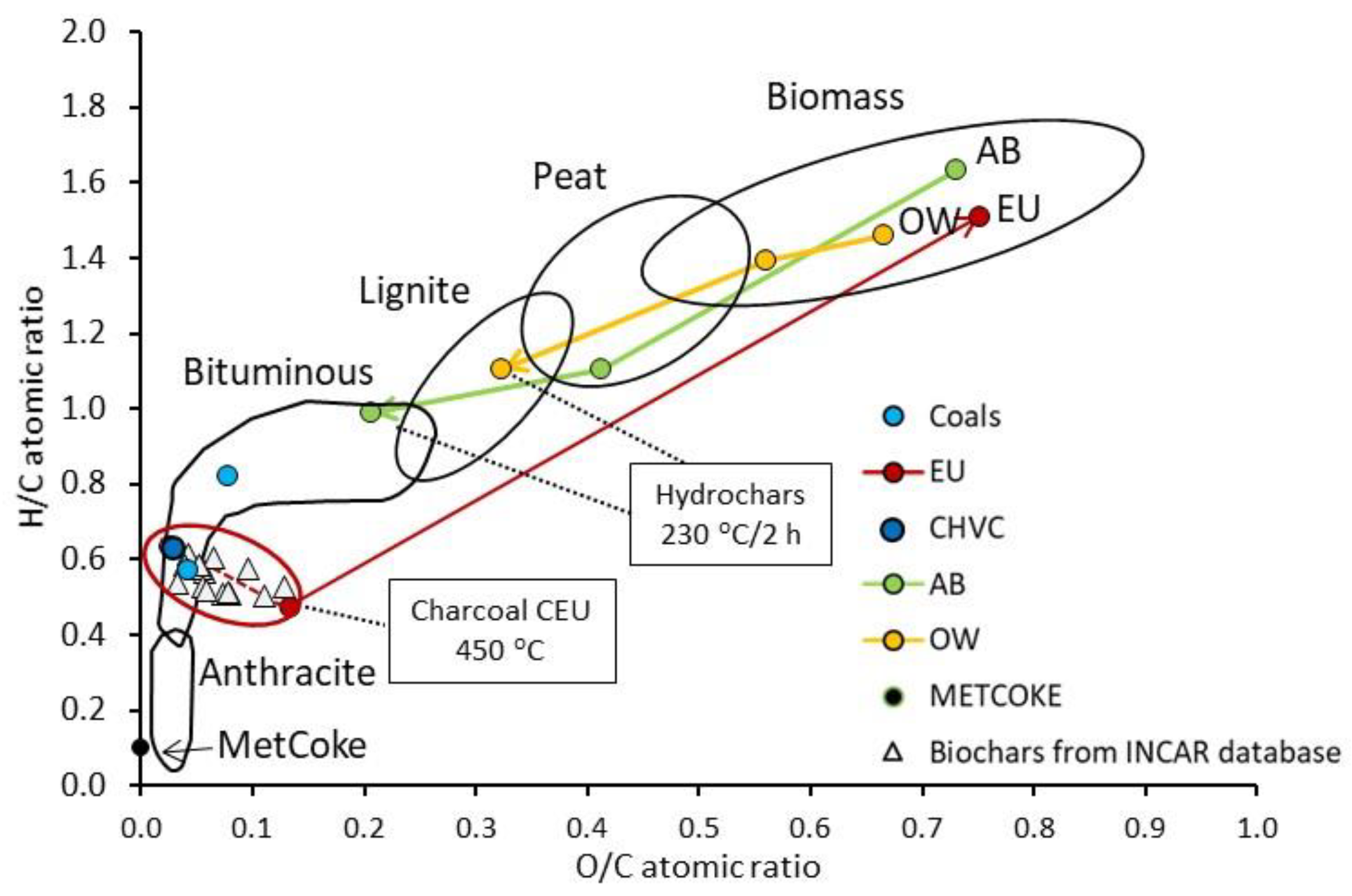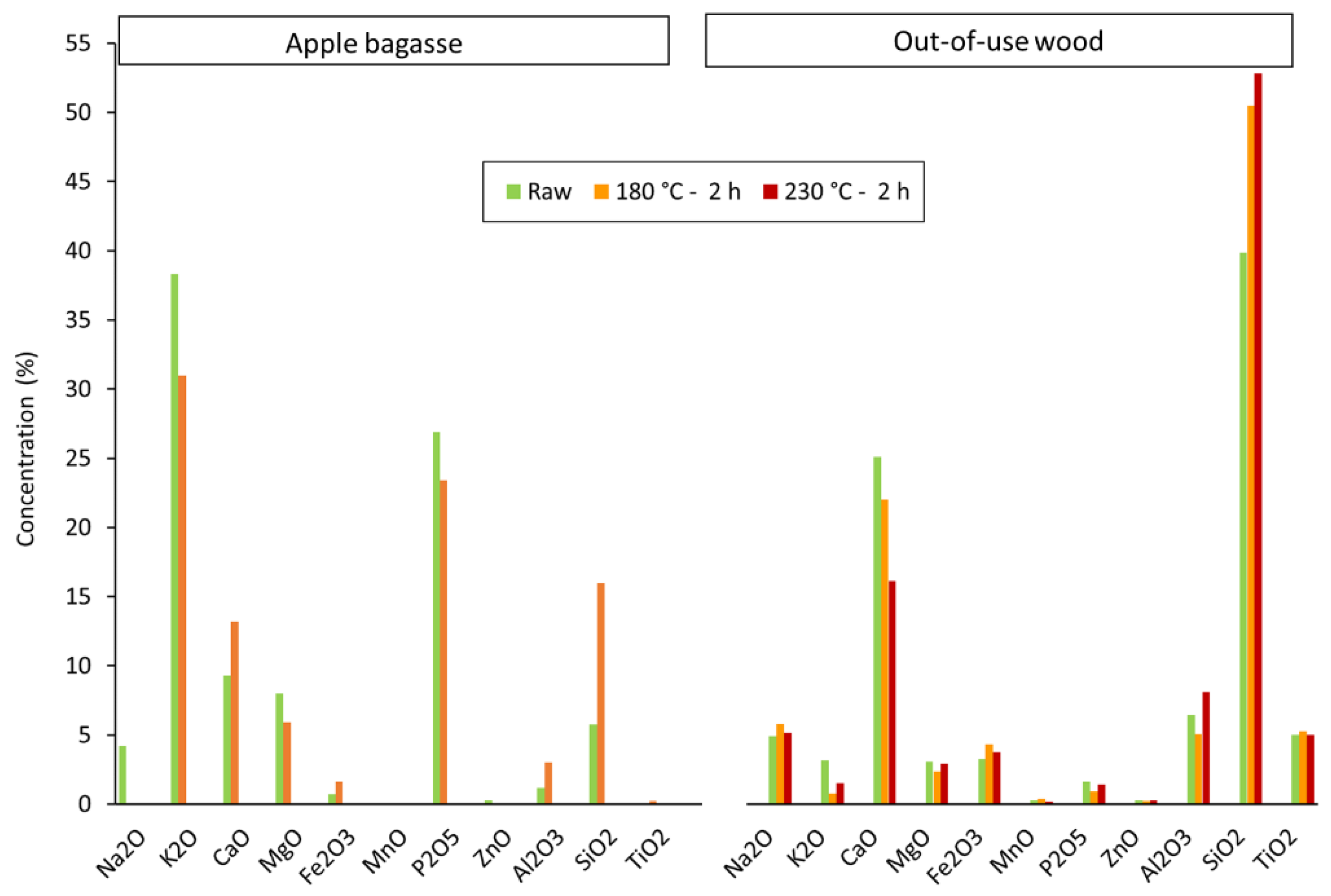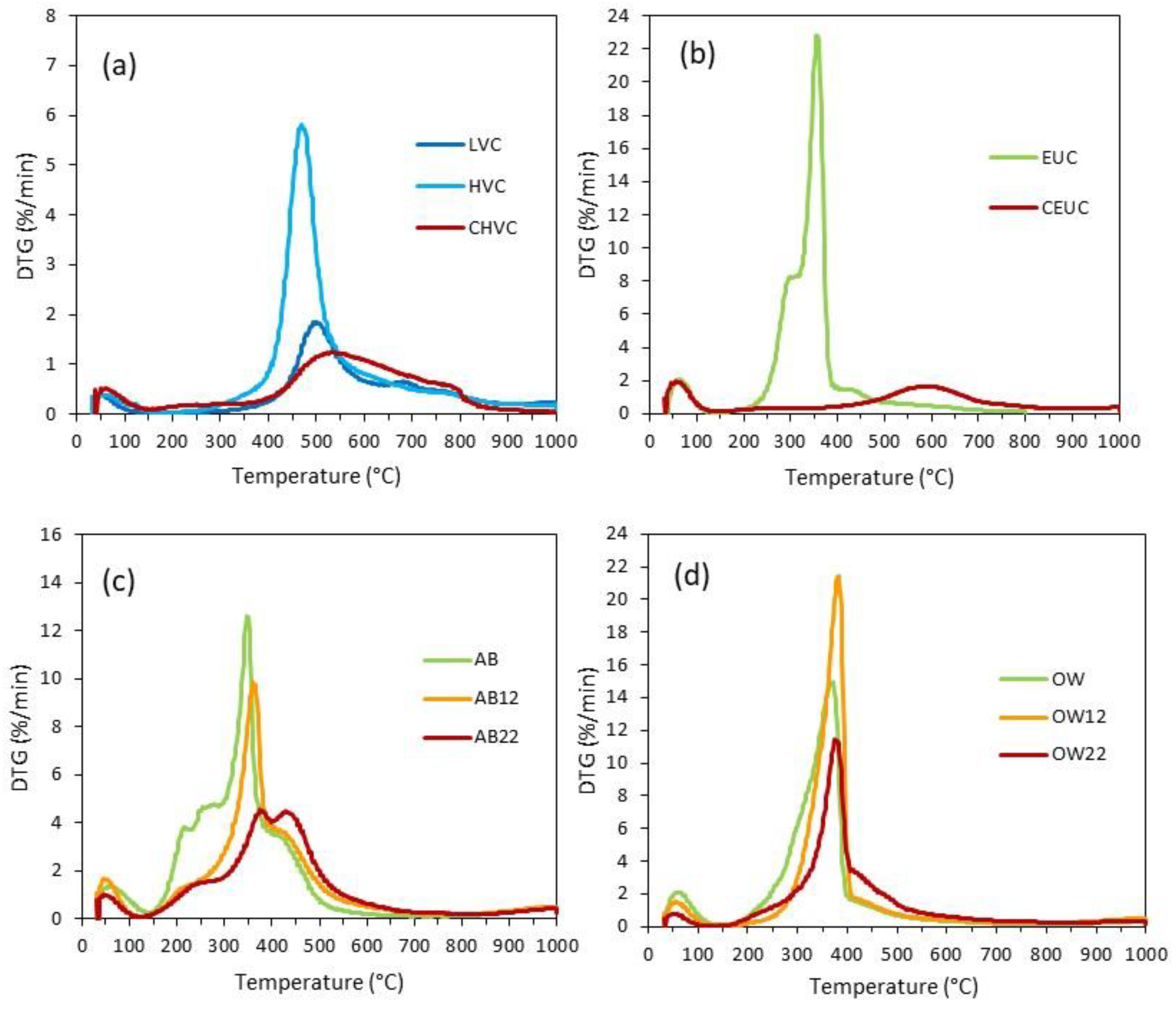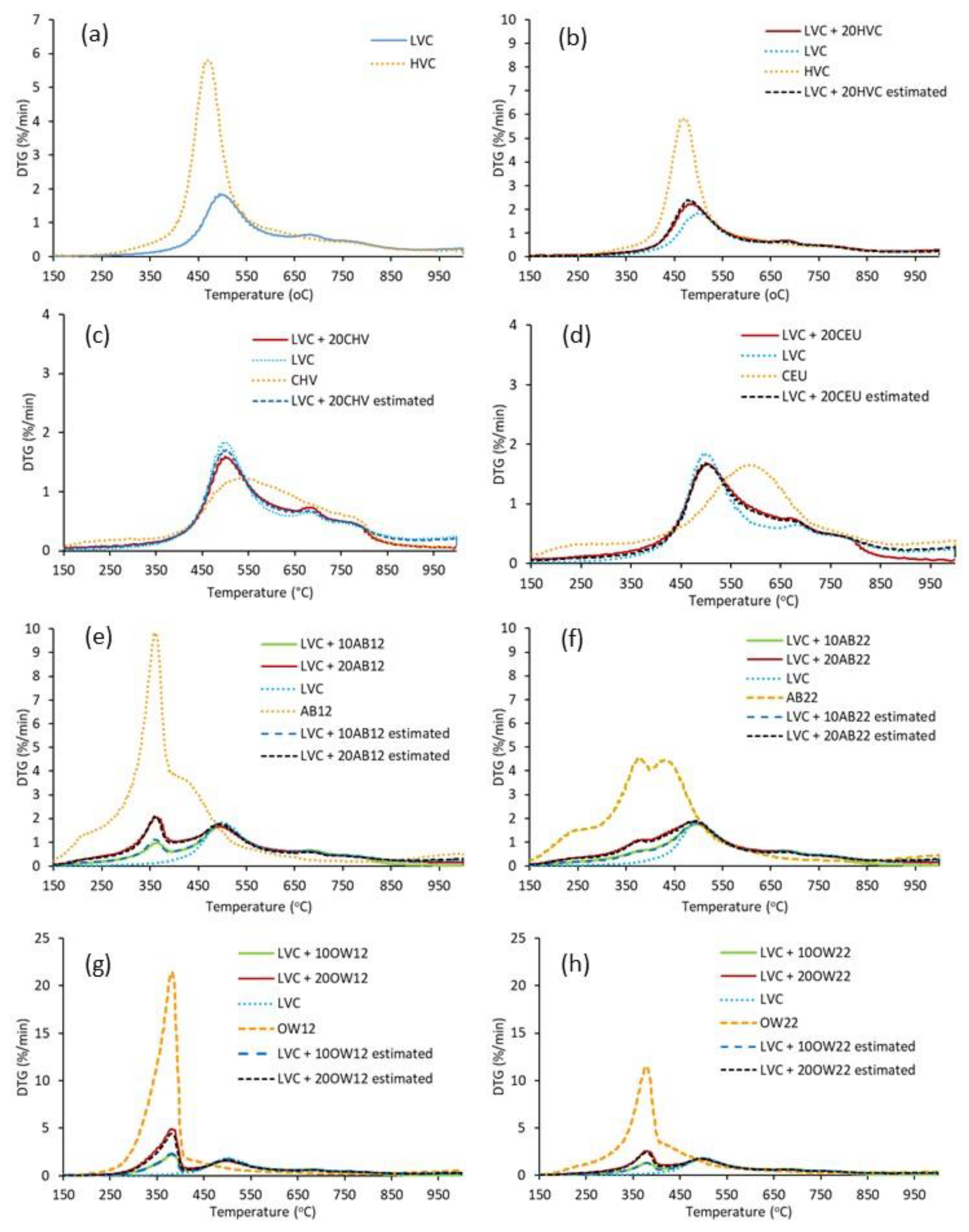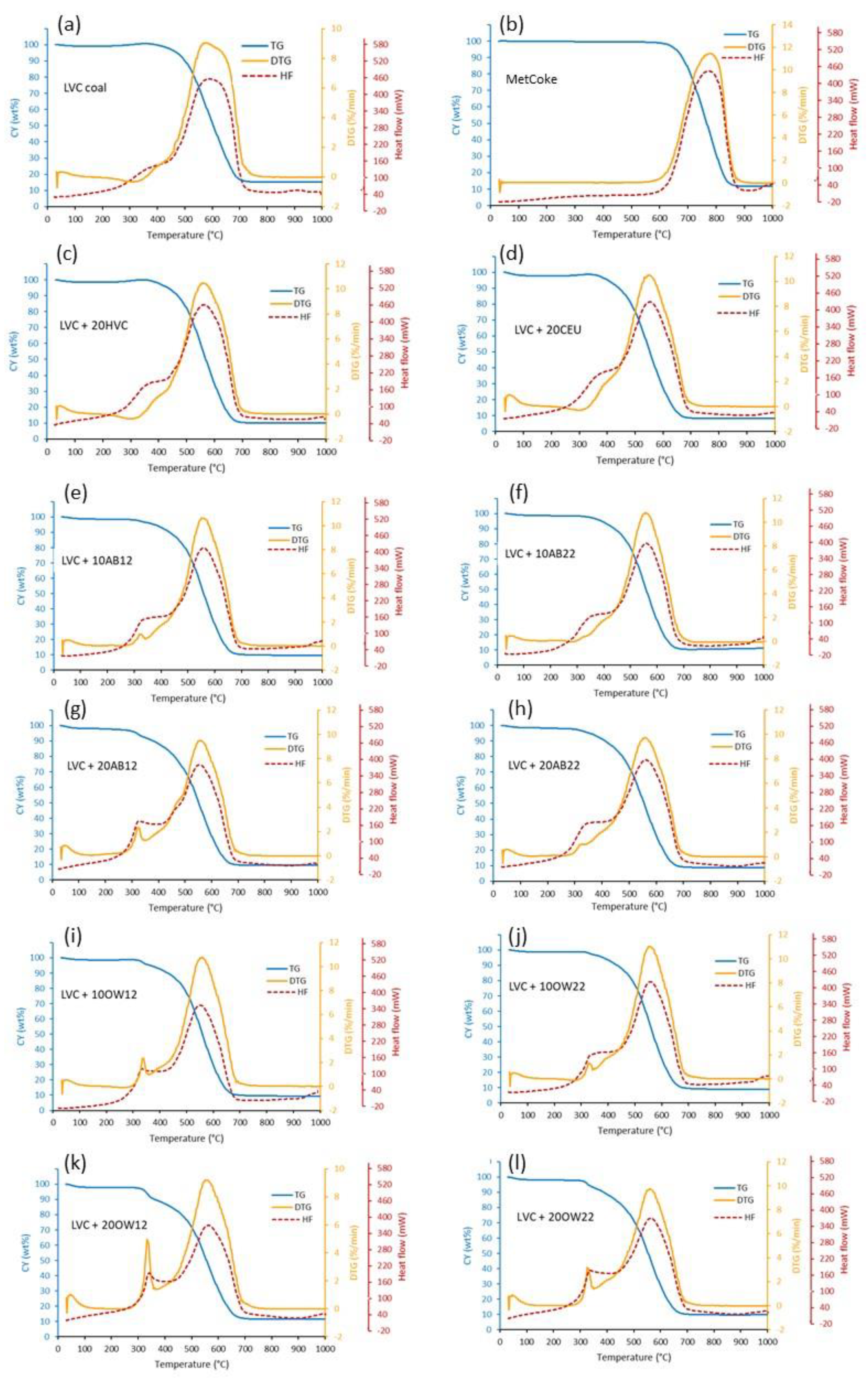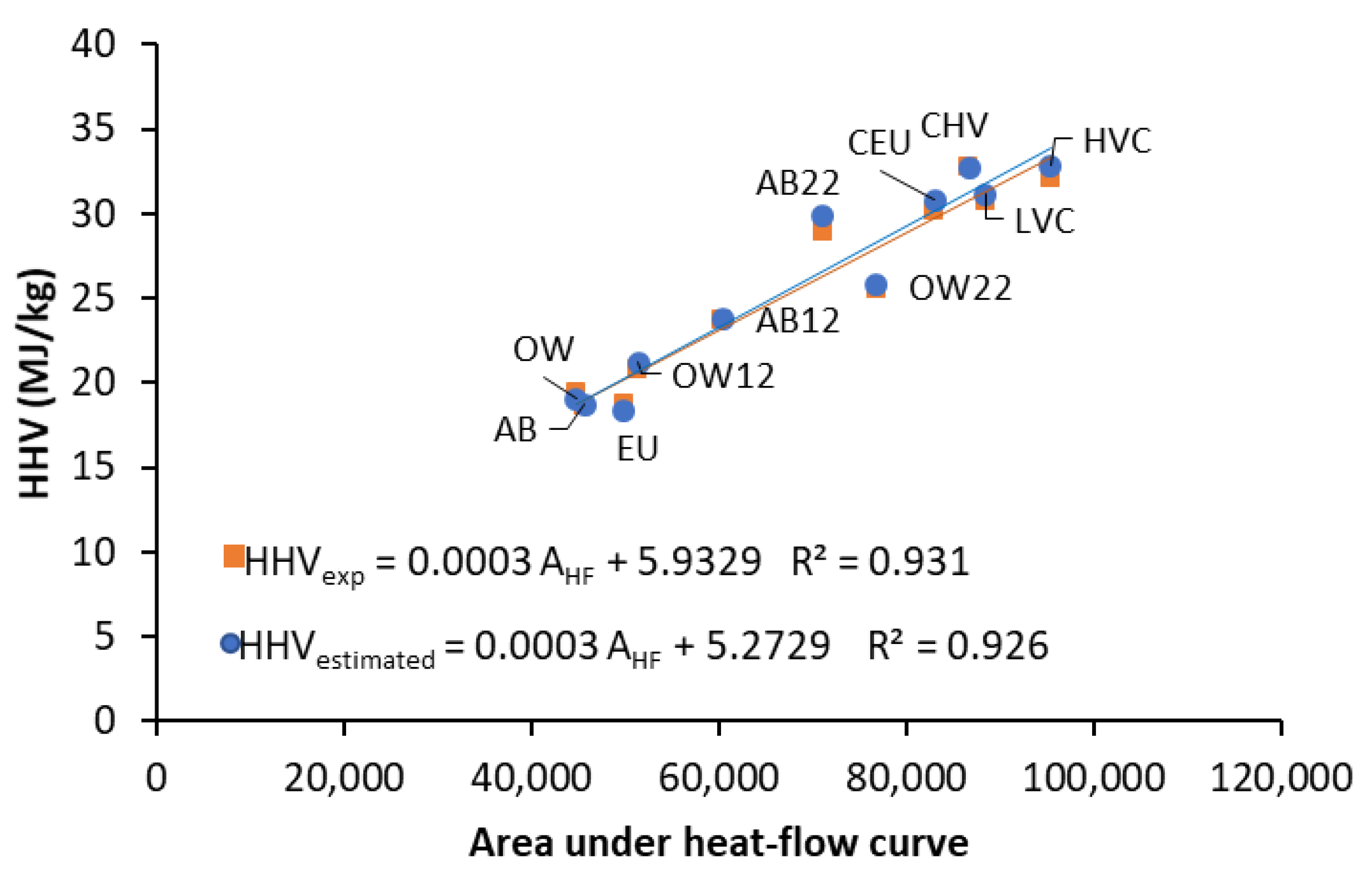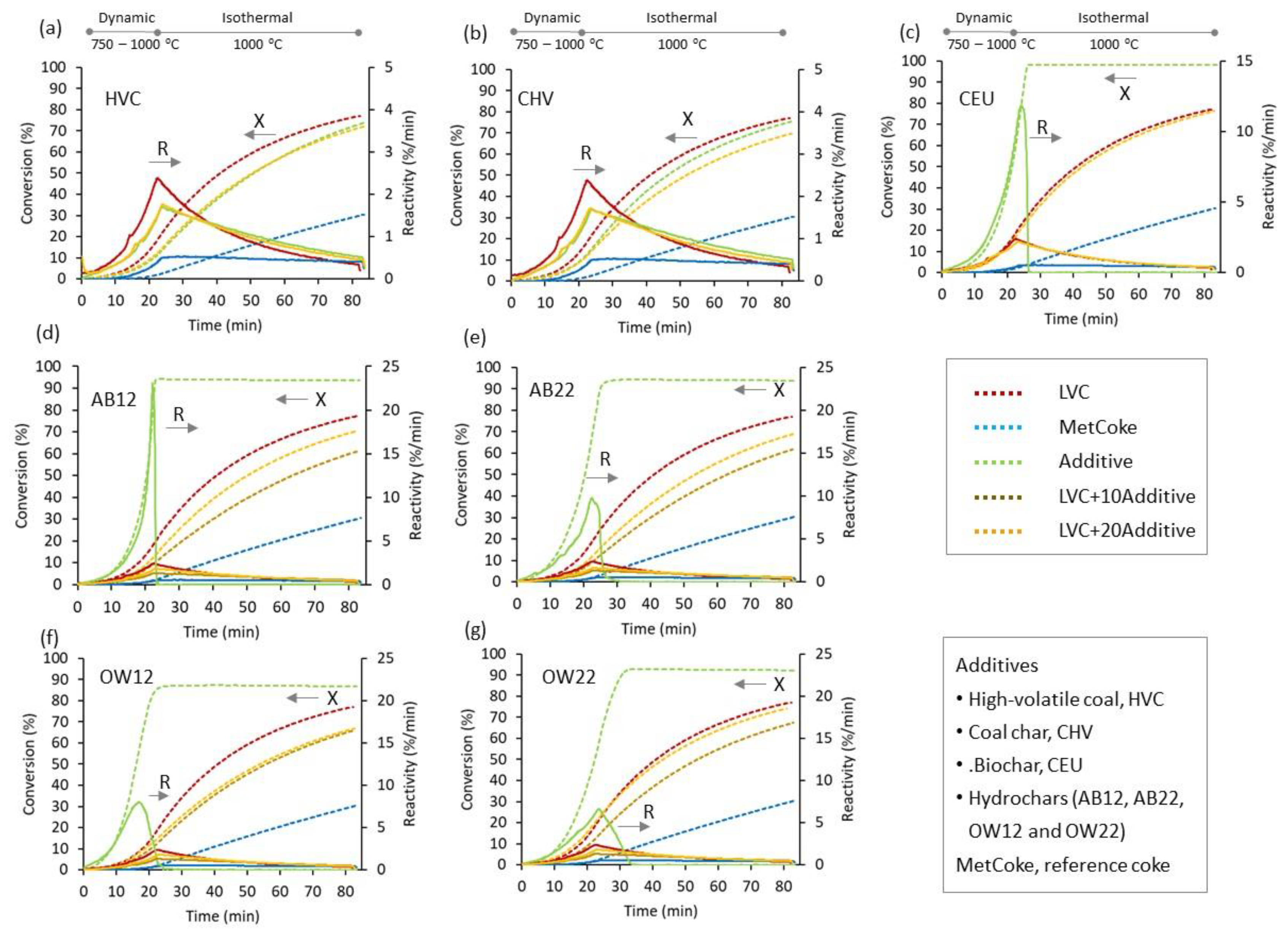3.1. Characteristics of Raw Materials and Thermochemical Conversion Products
A comparison of the main characteristics of the raw materials and the coal- and bio-based chars is shown in
Table 1. The two coals selected, LVC and HVC, had different ranks, with volatile matter content of 18.4 and 37.8 wt% db, respectively, and sulfur and ash contents below the preferred limits for injection in BFs [
13]. Both coals are often blended to optimize their composition and thermal behavior, reduce raw material costs, and dilute unfavorable characteristics of the components. The selected lignocellulosic materials were characterized by a high volatile matter (79.0–83.7 wt% db) and low ashes (0.16–2.30 wt% db), resulting in low fixed carbon (16.1–18.7 wt% db) compared to the two coals (56.5 and 70.9 wt% db for HVC and LVC coals, respectively).
Biomass, a composite material made up of three structural oxygen-rich biopolymers (hemicelluloses, cellulose and lignin), had a high oxygen content ranging between 42 and 46 wt% db and a low C content (about 46 wt% db), leading to much lower HHV and LHV than those of the low-rank coal HVC. One peculiarity of the wastes, the apple bagasse (AB) and out-of-use wood (OW), was the excessively high-water content, particularly for AB waste, rendering these raw wastes inadequate for energy.
The ash composition also contributes negatively to energetic applications. In particular, AB has unacceptable amounts of phosphorus and potassium in the ashes (
Table 2). For BF, such ash-forming elements, phosphorus and total alkalis (Na + K) in coal and coke must be kept as low as possible because phosphorus entering the BF ends up in the hot metal, affecting its quality. Potassium causes BF operating problems; it recirculates around the furnace before leaving either in the top gas or gradually builds up in the lower BF regions and, finally, in the slag. When deposited on the walls, it significantly impacts the lining life and furnace stability, and it also chemically attacks the carbon structure, accelerates carbon gasification and weakens the coke. The significant sources of P and alkaline elements (Na and K) in BFs come from the ashes of coal, coke, and the gangue materials in the ore, making it impossible to eliminate and limiting the quantity in the inputs is the only way to control the adverse effects [
12]. Although the optimum values for injectants strongly depend on the characteristics of BF and operational conditions, some indicative PCI coal specifications from different plants may have a desirable P amount, ranging from 0.01 to 0.06 wt% maximum, and alkali oxides (Na
2O plus K
2O) below 0.35 wt% [
12,
13], and similar levels were fixed for metallurgical coke [
29,
30,
31,
32].
Regarding the ash composition, other highlights can be drawn. All biomass ashes contained significant amounts of CaO, ranging between 9 wt% and 25 wt%, which were relatively higher than the quantities in coal ashes. Basic-Ca species can improve the BF reaction efficiency by reducing the fusion temperature and viscosity and acting as an effective catalyst in the gasification reaction of unburnt char. Additionally, eucalyptus ashes possess a predominance of iron that can significantly promote gasification reactivity.
In summary, from the chemical composition and thermal energy capacity—in terms of the P and K, moisture, volatile matter, more oxygen than C and H, and low calorific value—it is evident that the non-C species in the raw wood and biomass wastes are extremely high. Therefore, the fixed carbon and calorific value are too low to be used as fuel, although there may be other reasons for their utilization, mainly when waste materials are recovered in compliance with local environmental standards. In this context, pretreatments are required to produce a fuel with better specifications and higher energy densities closer to the PCI coals. Among the different processes for the optimal thermochemical conversion of raw biomass into an energetically valorized product, the chemical composition largely determines the process selection, with water content and ash composition influencing the choice of conversion pathway. Thus, slow carbonization at a low temperature was the selected process for eucalyptus wood. It yields around 38 wt% db of biochar of the type of charcoal (CEU), increasing the C content and HHV to levels closer to PCI coals and the char produced from the high-volatile coal (CHV) under the same conditions. As regards the raw lignocellulosic wastes, AB and OW, and due to the high-water levels, hydrothermal carbonization (HTC) was selected since such a process may significantly improve the characteristics of the organic and inorganic fractions of the low-grade biomass while avoiding the need for a drying pretreatment [
33].
Furthermore, HTC may provide an attractive approach to expanding non-fossil carbon resources for ironmaking if such wastes could be valorized to added-value products that meet fuel selection criteria. Applying the HTC process at two different temperatures, 180 and 230 °C, with 2 h soaking time, the water content of the hydrochars can be reduced by drying up to desirable levels (
Table 1), enhancing the handling and storage stability and producing a variation of the composition towards more thermally stable chemical constituents. The yield of solid hydrochars was 73 and 83 wt% on a dry basis at 180 °C, and 62 and 61 wt% at 230 °C for AB and OW, respectively.
Devolatilization of the precursors occurs, increasing carbon, substantially decreasing oxygen and giving a more carbon-enriched structure. Accordingly, the HHV increases to values between 20.8 and 28.9 MJ/kg, which fits into the coalification region of lignite and high-volatile bituminous coals [
34].
The degree of the compositional changes is linked to the temperature applied and the precursor treated. Devolatilization is higher for apple hydrochars than for out-of-use wood hydrochars, implying more remarkable structural and compositional modifications under the same conditions, probably due to the water acting as solvent and catalyst [
35] and to a higher quantity of thermally unstable constituents at low temperature contained in the precursor. All these changes are better visualized by plotting the O/C and H/C atomic ratios in the van Krevelen diagram (
Figure 1). As evidenced by elemental composition, apple hydrochars have higher development than out-of-use woods, reaching a bituminous coal-like state at the harshest conditions, while the HTC applied to OW gives products with still high oxygen content.
Based on these results, the out-of-use wood cell wall seems more resistant to the subcritical-water action and may need harsher conditions for a more remarkable evolution of the cell wall network. Nevertheless, compared to eucalyptus charcoal produced at relatively low-temperature and short residence time, the two hydrochars are still in the earlier region of coalification degree.
Figure 1 also shows an upward trend with decreasing O/C-increasing H/C from eucalyptus biochar towards the char from high-volatile coal (CHV) and the coalification region of LVC coal.
Moreover, there are more benefits to the HTC valorization of the wastes; not only is the organic fraction of the biomass feedstocks modified by the process but several differences in the ash composition of the solid products can also be observed. The two most abundant elements in raw apple bagasse are K and P, which account for nearly 65% of ashes, whereas in out-of-use-woods are Si and Ca (
Table 2).
HTC treatment of AB at low severity partially eliminates the harmful K and P elements (
Figure 2). Additionally, Na is practically removed as a significant element in the ashes (4.2% in AB vs. 0.01% in AB12), contributing to decreased alkali oxides. On the contrary, there is an increase in the presence of Si and Ca. Consequently, some inorganic species are generally solubilized by HTC, reducing the total ashes to less than 1 wt% compared to the parent material (
Table 1).
In the case of out-of-use woods, Si levels are further increased at the harshest conditions, whereas Ca levels are reduced due to the partial solubilization of some Ca-based mineral species during HTC (
Figure 2). Foreign constituents, such as titanium from paint chemicals in the original OW sample, are maintained at the same level (5%).
Insights into the thermal behavior and how the different fuels interact with coal under different atmospheres (inert and reactive), pyrolysis, combustion and CO
2-gasification of coals, raw biomass, and chars as single fuels are provided by thermogravimetric analysis. To overcome the inherent limitations of using biomass compared to coal, a series of binary blends with LVC as the base PCI coal and the different chars were prepared. The blend containing 20 wt% of the high-volatile coal (HVC) is used as an injection reference blend. Based on the ash chemistry of AB12 hydrochar, the replacement percentage ratio in the PCI blends was calculated as 10 and 20 wt% to achieve the BF input requirements (P, 0.04 wt% and alkali oxides 0.27 wt%). The limitation of high P and alkalinity in hydrochar ash has been reported by other authors, exploring the use of hydrochars from different feedstocks, e.g., lemon peels treated under a pressure of 2 MPa and an HTC temperature of 210 °C, for blending with anthracite in the steel production by different routes [
18].
3.2. Pyrolytic Behavior Using Thermogravimetry
Using thermogravimetry under pyrolysis conditions, the distribution of volatiles evolved during char formation as a function of temperature can be quantitatively evaluated.
Figure 3 shows the DTG profiles of the coals, raw biomasses, and the resultant coal- and bio-based chars. Additionally,
Table S1 summarizes some relevant parameters derived from the thermogravimetric analysis. The evolution of volatiles of the two coals corresponds to their rank. The HVC coal evolves the volatiles at a greater rate, DTG
max of 5.81 %/min, and a lower temperature (470 °C vs. 494 °C), starting around 325 °C, ending nearly to 990 °C and being the rate more gradual from 600 °C. Maximum weight loss occurs between 400 and 600 °C, and the quantity of volatile matter evolved is about 25.3 wt% in this temperature interval.
Regarding the char yield linked to the coal rank, a lower yield is obtained for HVC (63.7 vs. 80.6 wt%). The resultant CHV char at a laboratory scale exhibits a progressively less intense devolatilization in a broad temperature interval from 400 to 800 °C due to cracking and polymerization reactions of the C-network, as it is also seen for eucalyptus charcoal, with Tmax occurring at around 530 °C, and a char yield increases up to 79 wt% at the highest temperature.
Raw eucalyptus exhibits a typical DTG pattern of hardwoods where the cellulose coexists with hemicelluloses and lignin in complex physical and chemical associations within the cell wall [
36,
37]. In biomass wood resources, cellulose is the most abundant structural biopolymer (39–54 wt%), with hemicelluloses (20–30 wt%) surrounding the cellulose fibers and as a link between cellulose and lignin. The latter is a cross-linked phenolic polymer, which accounts for 19 to 26 wt%. Generally, hemicelluloses have a much lower molecular weight than cellulose; some are branched and soluble in alkali, easily hydrolyzed by acids, and less thermally stable [
38]. Non-structural organic compounds of different chemical classes (terpenes, proteins, tannins, fats and waxes) in various amounts (4–10 wt%) are also in wood. They are soluble in organic solvents or water (extractives) and are generally less thermally stable than structural biopolymers.
Concerning the thermal decomposition of such woody components, after water evaporation, structural transformation starts and ends at about 200 and 800 °C, respectively, and reaches a maximum devolatilization at around 355 °C. The peak at DTG
max is attributed to cellulose degradation, which reaches its maximum decomposition rate after the degradation of extractives and hemicelluloses, the breakdown of β-O-4 lignin bonds (more thermally unstable in less mature lignin), and hemicellulose/lignin connections (peak fronting at 300 °C) [
37]. Depending on the lignin maturity and thermal stability, lignin slowly breaks down over a wide temperature range, 200–800 °C, and tails off above 430 °C in the DTG profile (flat tailing peak). Compared to the precursor, CEU char exhibits a drastic change in DTG, and it undergoes cracking and polymerization reactions beyond 400 °C up to nearly 800 °C, producing a low and wide volatile evolution that moves towards much higher temperatures (T
max at 580 °C and DTG
max of 1.98 %/min). The partial overlapping of the volatile matter emission from the chars of eucalyptus and HVC, in the 400–800 °C range, is consistent with the elemental and proximate composition similarity (
Table 1). Considering that the HVC coal is used for PCI blending, the eucalyptus biochar seems to have great potential to substitute HVC coal.
Attending to apple bagasse and out-of-use wood, the pyrolysis of the starting wastes also follows the typical DTG pattern of lignocellulosic biomass [
36,
37]. Without considering the peak associated with water, hydrochars present significant changes at 150–300 °C, more pronounced at the more severe HTC conditions: reduction of extractives, hemicelluloses due to an acid-hydrolysis in the reaction medium to oligomers and monomers, and the less mature lignin that is easier to degrade. Highly condensed lignin that is more easily converted into char remains. All the composition modifications are associated with diminishing the volatiles evolved below 400 °C, and the increase detected at a much higher temperature (
Table S1).
In the case of out-of-use woods (
Figure 3), the DTG profile is similar to that of eucalyptus wood, although differences in the compositional distribution of structural and non-structural components bring some differences. The presence of extractives seems less pronounced, and the hemicelluloses are hardly detected (peak fronting at around 300 °C). For this waste, a mild HTC treatment appears to increase the DTG
max when extractives and hemicelluloses are partially removed, and cellulose decomposition occurs at a higher temperature with an increase in DTG
max (21.43 vs. 14.92 %/min). On the contrary, a more severe HTC treatment also causes a relative decrease in cellulose degradation, an increase in the lignin feature and an enhancement of hydrochar yield up to 35.6 wt%. The HTC process could be a promising recycling alternative to conventional waste disposal, contributing to new, high-value products tailored for a given application.
For AB, a different low-temperature pyrolysis pattern can be distinguished, which is associated with the compositional distribution of structural and non-structural components of this fruit processing waste. A primary peak at around 350 °C, attributed to cellulose decomposition, exhibits a maximum DTG of 12.63 %/min, with two partially overlapped shoulders with maximum decomposition rate at 212 and 280 °C associated with a mass loss of around 25 wt% and a last event after cellulose peak, which agrees with a high content of more mature lignin. AB is a pectin-rich lignocellulosic biomass containing around 20 wt% of the hetero-polysaccharides class with a core of α-1,4-D-galacturonic acid and several neutral sugars such as arabinose, galactose, among others [
39]. The lowest temperature shoulder at 212 °C is evident in this waste and is associated with the cleavage of the weakest C–O bonds of the acid and ester side groups in pectins [
40]. A second shoulder follows it between 250 and 300 °C, linked to hemicellulose degradation. Organic extractives also contribute to the volatile emission of up to 300 °C. The amount of extractives in this type of fruit-waste is also high, about 24 wt%; cellulose only accounts for nearly 18 wt%, and hemicellulose and lignin join the different layers of cell walls are around 10 and 25 wt%, respectively [
39].
One consequence of HTC treatment in AB is the delay of the Tmax attributed to cellulose and the decrease in the volatilization rate. Thus, as HTC conditions become more extreme, cellulose seems to be considerably affected and more modified in the hydrochar from apple bagasse at 230 °C (AB22). The reduction in conversion rate manifests the enhanced thermal stability of hydrochars over raw biomass, which varies considerably depending on the pyrolysis temperature (a decrease in volatiles evolved at 200–300 and 300–400 °C, with an increase in the 400–600 °C range). The char yield increases from 18.0 wt% for AB to 41.5 wt% for AB22.
Using biomass-derived products in PCI blends is a way to reduce CO
2 emissions in iron and steel production, expand the range of low-grade materials that can be used as fuels and contribute significantly to reducing negative impacts associated with wastes at a local level. In this context, the interactions between coal and coal- and bio-based chars during co-pyrolysis have been studied to determine whether the components of binary blends interact in some way that causes a different effect than expected by applying the additivity law.
Figure 4 shows the experimental DTG profiles of the single components, the binary blends, and the estimated DTG curves of the tested blends. Data derived from TG/DTG curves are summarized in
Table S2. After blending the LVC coal with the HVC coal and the different chars at 10 and 20 wt%, the co-pyrolysis DTG curves depict different patterns according to the additive (
Figure 4), where the devolatilization steps of the LVC coal and the hydrochars are distinguished. Regarding the influence of the waste amount added to LVC, it can be deduced that the higher the waste quantity, the higher the weight loss and the decomposition rate at the lowest temperature.
Independent thermal behavior is not the case for blends containing high-volatile coal, its char and the biochar from eucalyptus. The DTG patterns of these blends are associated with a great overlapping extent of the thermal breakdown of the organic coal matrix and the loss of the gaseous species of LVC coal. Thus, while adding 20 wt% of the high-volatile coal (HVC) to the high-rank coal increases the maximum degradation rate and lowers T
max, both chars present the opposite effect (
Table S2). However, any synergistic or antagonistic effects for char formation during co-pyrolysis could be discarded because the results clearly show a lack of interactions in the total weight loss during co-pyrolysis and, consequently, in the yield of the resultant char. Indeed, an excellent linear relationship between the experimental and calculated char yields at 600, 800 and 1000 °C indicates how well the additivity law predicts char yield, giving a coefficient of determination (R
2) of 0.999 and a slope close to the unit (
Figure S1).
3.3. Combustion Behavior Using Thermogravimetry
Non-isothermal combustion was performed to compare raw materials burning behavior and establish interactions, if any, between blend components. The TG-DTG-HF curves of single components and blends with LVC coal under the heating rate of 20 °C/min in an air atmosphere are shown in
Figure S2 and
Figure 5, respectively. One metallurgical coke with a moderate reactivity index (CRI) of 25.4% and high post-reaction strength (CSR) of 64.6% was also included for comparison purposes.
Tables S3 and S4 present the burning characteristics of the candidate fuels, their blends with LVC and the metallurgical coke. After water removal, LVC coal and non-biomass additives increase in weight (about 1% of the initial sample weight) as the oxygen is adsorbed on some active sites of the carbon surface and heat is generated. The process starts at about 160 °C and continues to 360 °C, corresponding to O
2 chemisorption [
41,
42,
43], thus resulting in negative DTG values and exothermic heat. After forming unstable oxy-coal complexes, the combustion begins with a rapid weight decrease and increased heat generation (exothermic HF peak), ending when the organic matter is completely consumed.
The O
2-chemisorption is not observed for biomass additives because devolatilization starts at this temperature, as seen by pyrolysis DTG curves (
Figure 3). Next, the loss of inherent moisture and chemisorption, the combustion process proceeds via overlapping chemical reactions where the first combustion stage belongs to devolatilization with ignition and combustion of the volatile release up to 400 °C. Above 400 °C, the process is dominated by the ignition and combustion of the carbon contained in the char, which ends at a temperature above 700 °C for coals and coal-char and at a lower temperature for biomasic material. The DTG shape of the LVC coal combustion is rather broad, starting near 450 °C due to a small amount of volatiles and a residual inorganic material of about 15 wt% remaining after combustion. According to coal rank, the HVC coal used in PCI blends has more volatile matter than LVC, and earlier devolatilization can be observed with the subsequent heat generation (
Table S3).
Meanwhile, the DTG patterns of the derived hydrochars split into two distinct stages linked to the devolatilization of untransformed components during HTC with the combustion of volatile species and the rapid transition to ignition and combustion of the carbonaceous material. The total energy balance in both steps is exothermic, where energy is released as heat. The pattern of DTG-HF is quite similar, and the main differences lie in the first region corresponding to the devolatilization associated with pyrolysis, where volatiles evolve at a temperature below 400 °C, producing up to 50% of the total heat generated. Hydrochars produced at 230 °C have a higher thermal stability (T
50) compared to hydrochars prepared at 180 °C, the highest combustibility range and the lowest reactivity (R
w) due to a lower presence of the most reactive carbon and oxygen functionalities (
Table S3). The combustion profiles are maintained when hydrochars are blended with the LVC coal, overlapping with the burning stage of the char from LVC coal at temperatures higher than 400 °C. The different additives sharpen the DTG profile and slightly decrease the T
max from 593 to around 575 °C (
Figure 5,
Table S4).
As observed in the two-step combustion HF curves, when C and H combine with oxygen to give CO
2 and H
2O, more heat is released that is required for devolatilization. The area under the heat flow curve (A
HF) represents the heat evolution during the oxidation reactions up to high temperature so that it could be related to the HHV of the sample, as determined with a bomb calorimeter.
Figure 6 shows a positive linear relation of A
HF with HHVs of the coals, biomass and chars obtained using a bomb calorimeter. Some scatter may, however, be observed due to the different nature of the samples. Nevertheless, the experimental and predicted HHVs are relatively close, differing only in less than 4 MJ/kg. For confirmation purposes,
Figure 6 also displays the HHV data calculated using the multiple regression model developed by Channiwala and Parikh [
27], which is based on the elemental composition. Carbon and hydrogen are the primary elements of the organic matter of the fuels that contribute to the calorific value; other elements and ashes have no positive contribution or only contribute slightly.
Remarkably, the trend lines plotted in
Figure 6 are practically the same, with less than 1 MJ/kg difference. Finally, the HHVs of the binary blends were estimated by applying the additivity law of the elemental composition and HHVs of their components and the values of the experimental heat flow during non-isothermal combustion (
Table S5). To this end, the heat flow measured during combustion in a thermobalance can be considered an adequate alternative to the bomb calorimeter method and safely used to predict the calorific value. It can also be noticed that simultaneously to heat flow, several specific burning parameters in TGA can be obtained by examining the TG-DTG curves to estimate fuel combustion performance.
3.4. CO2-Gasification Behavior Using Thermogravimetry
From a qualitative point of view, the CO
2-gasification profiles of the chars produced in situ at 800 °C from LVC and its blends with 10 and 20 wt% addition of coal and biomass during the previous pyrolysis step in the thermobalance seem to undergo a similar evolution. For comparison purposes, one metallurgical coke was also evaluated. The CO
2-reactivity reaches a maximum value (R
max) at 1000 °C at the end of the dynamic step (21–24 min), decreasing as the reaction progresses in the isothermal step at 1000 °C in the oven and tending towards stability with gasification time due to less available sites per residual mass and more resistant to the CO
2 action. Such overall behavior obeys the well-known patterns of porous coal-based materials that depend on the access of CO
2 to the internal surface area of the in situ chars and the presence of catalytic species [
44,
45].
Figure 7 compares the reactivity and conversion profiles of the chars, and
Table S6 reflects the differences and similarities of the different blends and coke by the most relevant CO
2-gasification parameters derived from the mass change during the dynamic and isothermal steps. Additionally, data corresponding to single additives are listed in
Table S7.
An examination of the reactivity and conversion degree of the chars produced in situ during pyrolysis at 800 °C reveals some remarkable features that reflect their response to the action of CO
2. For instance, a remarkable similarity in the behavior of the coal chars produced in situ and by laboratory oven when blending with LVC (graphs marked in
Figure 7 as HVC and CHV, respectively) can be observed. There is an overlap throughout the process with the char produced from the main component of the blend (LVC base-coal char) that dominates the gasification process. It also seems that the differences in the reactivity and conversion of the resultant chars are not very pronounced, since they have similar values at any degree (
Table S5). On the contrary, metallurgical coke differs markedly from blends composed of coal- and biomass-derived chars. Because of its graphitizable carbon structure with fewer active sites participating in the C-CO
2 reaction and less open structure, the high-temperature coke exhibits the lowest final conversion (X
f = 30.4% vs. 61.8–77.1%) and reactivity (R
max = 0.54 %/min
vs. 1.30–2.38 %/min) under the conditions employed together to the highest gasification start temperature (T
initial = 929 °C
vs. below 870 °C).
There are inherent differences when only biomass additives from the different parent materials are compared. The situation of the low-temperature eucalyptus char (CEU) is comparable to that of the out-of-use woods hydrochar prepared at 230 °C (OW22) blended at 20 wt%. The chars from these blends are the most reactive at any specific conversion degree; the onset temperature of the Boudouard reaction is nearly the same and close to the LVC coal, and they achieve a higher final conversion than the other chars. The OW22 hydrochar is greatly affected by its previous hydrothermal history at 230 °C where the degradation pathway of carbohydrates and reactive compounds during HTC induces a hydrochar with lignin, contributing to a greater extent to char formation at 800 °C. This finding is consistent with the pyrolysis behavior evidenced by TGA in
Figure 4 (
Section 3.2). With respect to this, the higher reactivity of LVC + OW22 due to a higher concentration of lignin than polysaccharides is in line with the variations found in the CO
2-reactivity of high-temperature cokes obtained from blends of coking coals with a small addition of hemicellulose, cellulose, and lignin [
16]. For high-temperature biocokes, the original biopolymers retain their structure but distortedly, and lignin has the most marked effect on coke reactivity, reaching the highest R
max in a shortest reaction time and the highest final conversion. When cellulose is added, biocoke exhibits an intermediate R
max, while xylan, a representative of hemicelluloses, has a moderate effect on coke reactivity [
16,
45]. However, other biomass wastes containing a high content of carbohydrates and a low content of lignin, like in blends with AB addition, give less-reactive chars. Regarding the increasing amount of the additive from 10 to 20% by weight, there is an increase in the degree of final conversion achieved (X
f), a reduction in the threshold or starting temperature of gasification and those at low conversion degrees, resulting in more reactive chars. The significant reduction in reactivity can initially be explained by the relative amount of carbon formed from polysaccharides and lignin, since it must be an essential factor in controlling the formation of amorphous carbon and porous structure during the previous pyrolysis stage. In addition, it has been shown that hydrochars from apple bagasse at the two temperatures, 180 and 230 °C, lead to carbon forms less susceptible to being attacked by CO
2.
